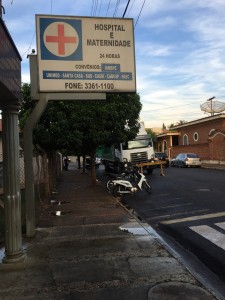On our first or second week in Barretos, we accompanied the manager of the prevention department, Edmundo, to two of the regionally stationed mobile units; one in Monte Azul and one in Viradouro. Both focused on breast and cervical cancer prevention, performing pap smears and mammograms for women of the region. Because our visit was brief, we decided to ask Amanda, the nurse in charge of organizing the mobile vans, one direct question. “What is the hardest part of this system?” Looking at the truck carrying a mammography machine up and down the bumpy roads of Brazil you would think there could be a lot of difficult things about trying to cover 100% of the women needing cancer prevention treatment. Amanda’s response, however, was simple. Getting women to come.
The mobile unit stationed in Viradouro
The unit outside the clinic in Monte Azul
It seems like the hospital has already thought of everything. How they would deliver top quality cancer care, distribute this care to remote regions with little health infrastructure and transport the equipment and materials to these patients without sacrificing quality. The issue Amanda and organizers of the regionalmobile vans are struggling with is a little less straightforward than a nifty suspension system to put delicate equipment in a truck. They are confronted with the perceptions, fears and beliefs of a society that does not commonly view annual cancer prevention exams as routine like in the U.S. Although many of our project ideas have been more engineering focused, the problem of persuading women and patients to actively seek and sustain treatment is a challenge we wanted to further explore.
A few weeks later we met with Amanda to find out more about the system. She described to us the Rastreamento (translated by Google as “tracking”) project. Its objective is to achieve 100% coverage of the target populations for cervical, breast, prostate and oral cancer in the 18 cities of Barretos’ health district, DRS-V. We were only barely introduced and it already seemed like a huge feat. The more we learned, the more we realized a lot of the project’s success depended on the regional cities’ medical staff. They are trained about 60 days in advance of the van’s arrival to promote its services and fill all the available appointment slots. Amanda described the following campaigning initiatives that are or have been standardly used by the hospital and the cities:
- “Carros de som” (sound cars) that announce the van’s arrival, location and purpose
- Radio interviews in cities that have local stations
- Announcements in churches
- Pamphlets handed out at schools for students to give to their parents
- Personalized letter invitations to patients that are in the target age range
The issue was definitely not a lack of advertising. The next day we accompanied Amanda to the small city of Cajobi where the mobile unit is scheduled to visit from the end of August to mid September. The room was filled with about 20 people; a few nurses and the rest were community health workers, each responsible for visiting every house in their section of the city. After explaining the project, campaign talk began with a constant emphasis by Amanda to get all the available appointments filled with patients. Many of the community workers expressed their concern with convincing enough people to go even though they would be giving their population face-to-face invitations. We asked why some people resisted going, and three of them stuck out to me…
- “Quem procura acha” (Who seeks, finds.) : Many patients fear discovering they have cancer and would rather not know. The positive notion of finding, but finding early enough to treat and cure, is not as commonly held.
- Seeking a doctor only when something hurts : Preventative measures such as the one Rastreamento is built on is more difficult for people to actively seek as many can not dissociate seeking medical attention with disease and illness.
- Locomotion: Not all patients can easily find transportation from their area of residence to the mobile unit, even if that unit brought services from, Barretos a bit closer.
So now I ask myself how can these mentalities be changed? Introducing an education component to the advertising performed by the small cities and BCH for the Rastreamento project has not been tried before. Amanda recommended that such an initiative should be not only informative but also easy to understand, not take too much time to understand and, ideally, sustain self-promotion. Definitely a tricky challenge. Fortunately, some of the great things Rice University has to offer are minds that can work together, think and solve problems. We’re bringing this one back for ya Rice!


